In 2023, an outgoing loan of several paintings on display at Bristol Museum & Art Gallery provided an opportunity to revitalise a display of paintings in a key location in the museum building.
One painting being loaned – The Last Moments of Raphael by Henry Nelson O’Neil – had been on display on the main staircase connecting the entrance hall of the museum to the top floor art galleries for around four years, but other paintings displayed with it (figs 1 & 2) had been in situ for at least 30 years. Their selection was probably related to the main entrance of the museum being the Winterstoke Hall, named after William Henry Wills, Lord Winterstoke, who gifted the Art Gallery to the city in 1905: the paintings included a portrait of Wills, and a work he had given to the collections.
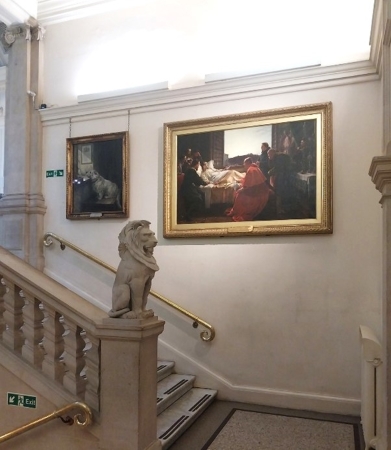
left to right: Funeral of King Charles I by Ernest Crofts; William Henry Wills, Esq., M.P. (Lord Winterstoke) by Edward John Gregory
© Bristol Museums
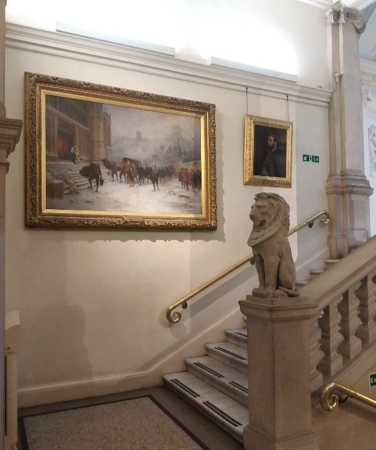
left to right: Funeral of King Charles I by Ernest Crofts; William Henry Wills, Esq., M.P. (Lord Winterstoke) by Edward John Gregory
© Bristol Museums
Refreshment of this display had long been discussed, not least because the source of the Wills wealth – the tobacco industry – is one that requires careful examination as part of ongoing work to decolonise museum collections and their interpretation. The four works were also not particularly representative of the displays in the picture galleries, and it was considered that there were works in storage which could better contribute to the narratives and themes explored elsewhere in the building and at other museum sites. This was an opportunity to put these works on public view.
There was also a significant Conservation and Collections Care need to change the display. The staircase is a very open space, and its environmental conditions cannot be controlled. It was a concern that three of the four paintings on display were not protected by glazing of any kind, making them more vulnerable to environmental fluctuations. In addition, the position of this staircase in a building on a busy main road means that unglazed works are exposed to accumulation of damaging particulate dirt from pollution, which could not be removed without the need for scaffolding and closure of the staircase. The paintings selected for the new display therefore needed to be glazed and backed before they were put up.
The new paintings selected (figs 3-6) were chosen because they each represent a significant style, topic or theme, but also inform and complement each other when displayed together.
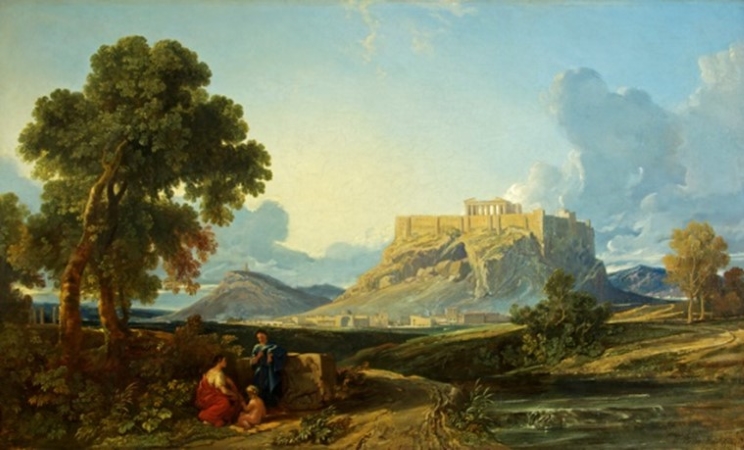
The Acropolis, Athens, William. J. Müller, 1843 (K202)
© Bristol Museums
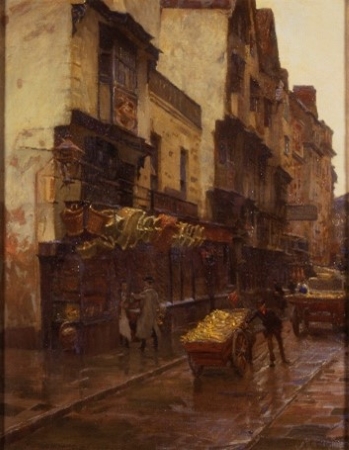
Mary-le-Port Street, Bristol (The Cradle of the Wills Tobacco Firm)
William H. Y. Titcomb, c.1902 (K5962)
© Bristol Museums
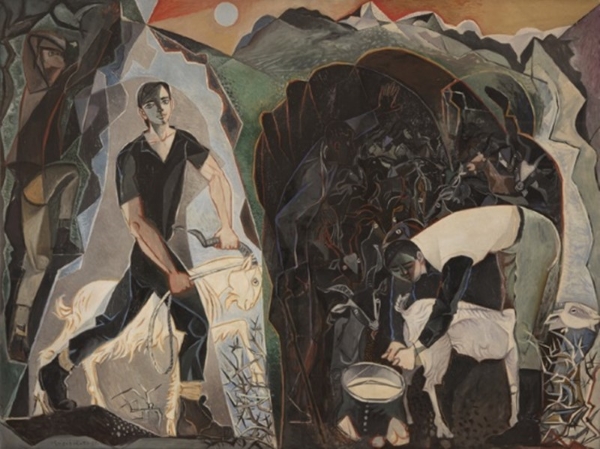
Four Figures in a Mountain Landscape, John Craxton, 1950-51 (K2234)
© Estate of John Craxton. All Rights Reserved, DACS 2024. Photo Credit: Bristol Museums
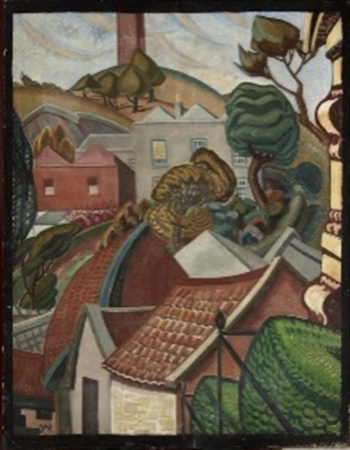
Brandon Hill, Doris Hatt, 1931 (K6476)
© the copyright holder. Photo credit: Bristol Museums
The Müller and Craxton illustrate art’s obsession with ancient and modern Greece; a contrast of classical and modern echoed by the differing depictions of Bristol in the Hatt and Titcomb paintings. Müller was a Bristol-connected artist, and his works are in other galleries in the museum and at Blaise Museum. The Craxton painting is a jewel of Bristol’s collection of twentieth century art, with its kaleidoscopic visual language inspired by Cubism. Its inclusion also links to representation and interpretation of work by LGBTQ+ artists throughout our displays. The Doris Hatt painting is also part of this theme, as well as visually complementing the Craxton in style. This painting is a relatively recent acquisition – via a bequest and the Friends of Bristol Art Gallery – which had not previously been displayed at any of Bristol Museums’ sites. Hanging this painting in this prominent location also brings to the fore work by female artists. Titcomb’s painting of a local scene – albeit one that no longer exists, the road having been destroyed in WW2 – allows the Winterstoke connection to be maintained while presenting an opportunity for thoughtful interpretation about the link between Wills Tobacco and the museum.
The conservation considerations were also factored into the selection. An anti-reflect material was needed as otherwise the lighting on the staircase would produce distracting reflections. Of the four proposed works, only the Hatt was already framed to this level, with Tru Vue UltraVue® 4.4mm laminated glass. The other pictures had either standard acrylic or thin, reflective glass. For the larger works, it was realised that glass of the sizes required would make the works prohibitively heavy to lift to their hanging height, and the Craxton frame is also not robust enough to take the weight of a large sheet of glass.
Tru Vue® Optium Museum Acrylic® was therefore the ideal solution, allowing physical and environmental protection with minimal additional weight while also eliminating problem reflections.
The project moved ahead in three stages: taking down the old display and refinishing the walls; preparation of the paintings for the new display; hanging the new display.
The old display was taken down in December 2023, with the public informed in advance. The large pictures necessitated scaffolding and assistance from professional art handlers from Art Works Exhibition Services for the removal of all four paintings to storage. The opportunity was then taken to paint the walls of the staircase, where marks from the old paintings were clearly visible, and to fill old holes from previous hanging fittings.
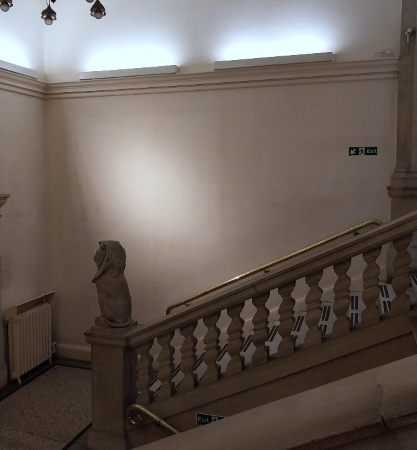
Marks left on wall after removal of old display
© Bristol Museums
While this was happening, the paintings for the new display were prepared. Only minimal conservation work was required for the paintings: the Titcomb painting was surface-cleaned to remove a build-up of dust and dirt, but the other paintings were all in good condition. The frames required more work, with surface-cleaning, filling and retouching of losses, and some adjustment to the rebate required for the Müller and Titcomb frames. The pieces of Optium acrylic were then fitted into the three frames, followed by the paintings and backboards.
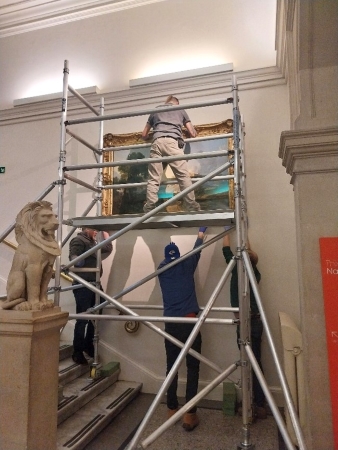
Technicians hanging Müller’s Acropolis
© Bristol Museums
The re-hang took place in early February 2024, again assisted by professional art handlers. The paintings are secured using a combination of hooks and straps, L-brackets and mirror-plates.

Panoramic view of the final display
© Bristol Museums
The redisplay was an immediate success, with positive feedback received from museum staff and visitors. There has been particular enthusiasm about the inclusion of the modern paintings, especially the Craxton.
This project would not have been possible without the practical support of Tru Vue. In combination with the loan which prompted it, the Tru Vue in-kind donation allowed us to revitalise and refresh a focal point of the museum. The redisplay has transformed this space into an integral part of a wider display narrative, tying together themes and ideas from across the museum. The Tru Vue Optium Museum Acrylic protects these pictures, and allows them to be accessed and enjoyed, so they can inspire our visitors now and in the future to new ways of looking at Bristol Museum & Art Gallery’s collections.
Share this Article:
This article is intended for educational purposes only and does not replace independent professional judgment. Statements of fact and opinions expressed are those of the author(s) individually and, unless expressly stated to the contrary, are not the opinion or position of Tru Vue or its employees. Tru Vue does not endorse or approve, and assumes no responsibility for, the content, accuracy or completeness of the information presented.